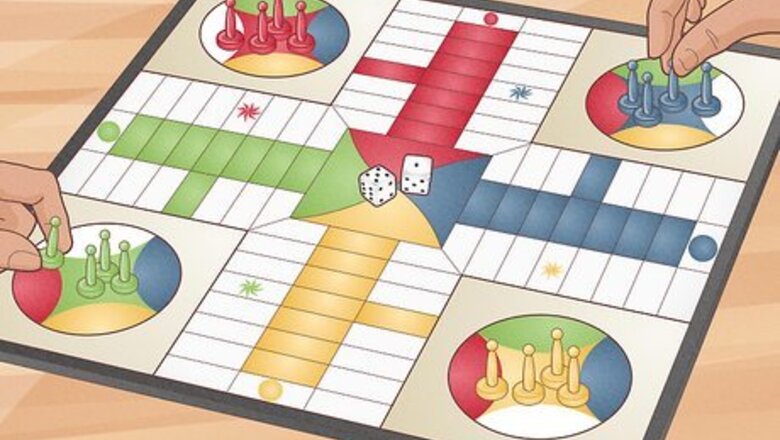
views
- Number of players: 2 to 4 players
- Game pieces: 1 Parcheesi game board, 16 pawns, 2 dice
- Objective: Be the first person to move all 4 of your pawns around the game board and into the center Home space.
Game Set-Up
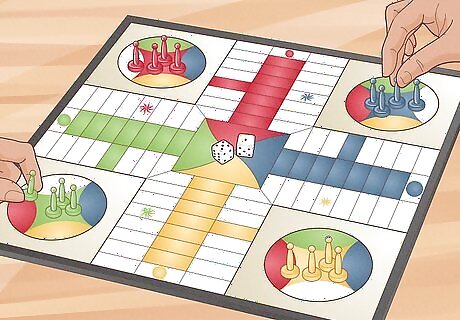
Place the pawns in their respective Start circles. Parcheesi consists of 16 pawns, 2 dice, and 1 gameboard. Group the pawns by color (red, yellow, blue, and green for most versions), then place them in the Start circle that matches their color. In some versions of the game, the Start circle has 4 colored sections around it. Whichever color is next to the Enter space (a blue square with a circle in the center) indicates the color pawns that should be in that Start circle. For example, if you’re playing with the green pawns, look for the Start circle that has the green section next to the Enter space. There’s also usually a small arrow pointing from the Start circle to the Enter space that tells you where you’re supposed to enter your pawns onto the board. Sit so that your Start circle is to your right.
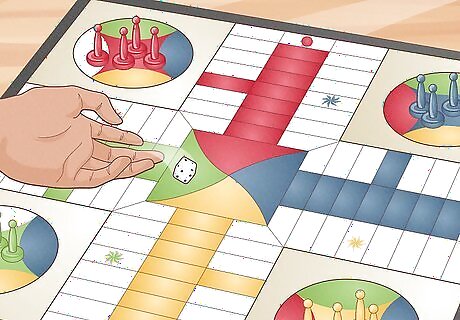
Roll the dice to see who goes first. Have each player roll one of the dice. Whoever throws the lowest number goes first. Then, take turns going clockwise around the table. Another option is to have the person who rolls the highest number start off the game. Up to 4 players can play a game of Parcheesi.
Entering the Board
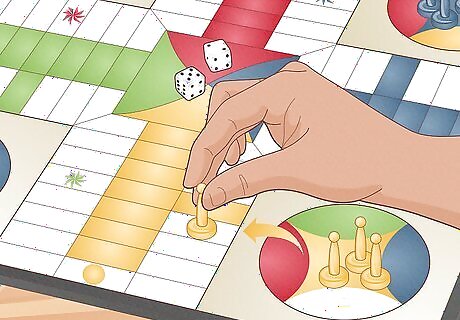
Roll a 5 to enter a pawn onto the board. You can only start moving a pawn around the board once you’ve rolled a 5. When placing a pawn on the board, put it on the blue Enter square next to your Start circle. Since there are 2 dice, you can take out a new pawn either when one die shows a 5 or when the two dice add up to 5. For example, if you roll the dice and get a 5 and a 2, take 1 pawn out of your Start circle and then use the remaining 2 to move that pawn or a different one forward 2 spaces. Rolling a 2 and a 3 adds up to a total of 5. In this case, take a pawn out of your Start circle and place it on the Enter square. You must take a pawn out of your Start circle whenever you roll a 5 until all of your pawns are on the board. If you roll two 5s, you can move 2 pawns onto the Enter square if there isn’t already a pawn there. If there is, move just 1 pawn out of the Start circle then use the remaining 5 to move a pawn forward 5 spaces.
Moving Pawns Around the Board
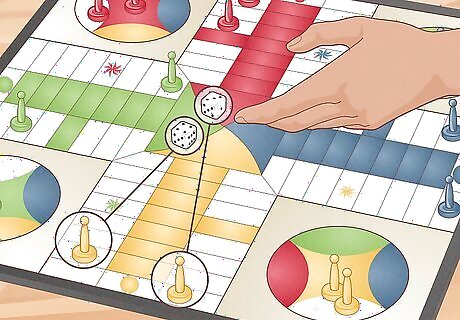
Roll the dice to move your pawns. When it’s your turn, roll the dice and move your pawns clockwise around the board. You must move whenever possible. You have the option to move 1 pawn by the total sum of the dice or split the sum between 2 pawns. For example: If you roll a 3 and a 4, you can either move one pawn forward 7 spaces or move one pawn forward by 3 and another pawn forward by 4. You can only move your pawns forward by the numbers that are on the dice. For example, if you roll a 5 and a 3 for a sum of 8, you can’t split it so that one pawn moves forward 6 and another 2 (for a total of 8). You have to split it so that one pawn moves 5 spaces and another pawn moves 3 spaces. You can’t split one roll between more than 2 pawns.
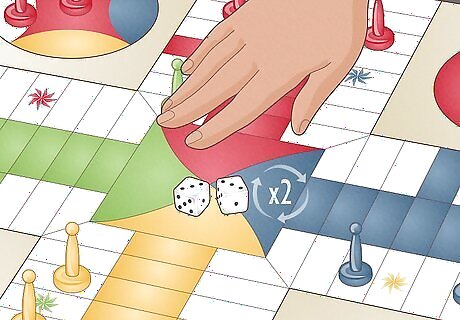
Take another turn when you roll doublets. A doublet is when you roll the same number on both dice. After you’ve moved your pawns, roll the dice again. If you roll doublets a second time, move your pawns and roll the dice one more time. However, if you roll doublets a third time, take the pawn closest to your Home (the center of the board) and place it back in your Start circle. Even if your pawn is on the Home path (the colored path to the left of your Start circle leading to the center of the board), you’ll need to return it to the Start circle if it’s the pawn closest to Home.
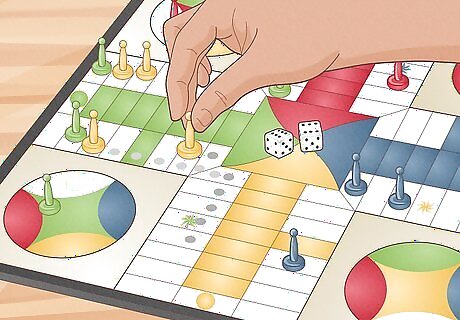
Move forward 14 spaces if all 4 pawns are on the board when you roll doublets. If you’ve moved all 4 of your pawns from the Start circle onto the board, then you get to move your pawns by the sum of the 4 numbers on the tops and bottoms of the dice. The sum will always be 14. Use the 4 numbers in any combination to move 1 or more pawns. For example: If you roll two 6s, use the two 6s on the tops of the dice and the two 1s on the bottoms to make your move. If you decide to split the move between 2 pawns, the following combinations are possible: Move 1 pawn forward 12 (6 and 6) and the other pawn 2 (1 and 1) Move both pawns forward 7 (6 and 1) Move 1 pawn forward 13 (6, 6, and 1) and the other pawn 1 Roll again after you’ve moved your pawns. If you roll doublets a second time, you get another bonus (14 moves). If you roll doublets a third time, take the pawn closest to your Home and put it back in your Start circle. If you can’t move your pawns using all 4 parts of your bonus, you don’t get to move any of your pawns but still get to roll again.
Creating Blockades
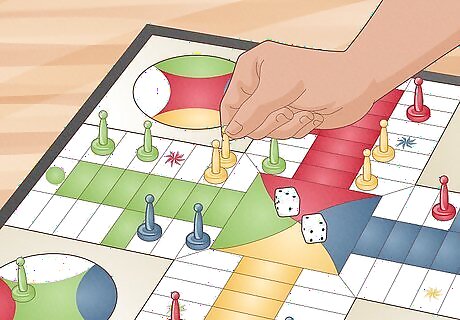
Place two of your pawns on the same spot to block players. You can have up to 2 of your pawns occupying the same spot on the board. When this happens, you create a blockade that other players can’t pass, capture, or land on. The only downside is that any of your pawns caught behind this blockade also can’t pass until you move one of the pawns creating the blockade. You’re allowed to leave the blockade up so long as you’re able to move other pawns around the board. If you roll and your only option is to move a pawn from your blockade, you must move that pawn. You can’t move the two pawns of a blockade forward to immediately make another blockade. No more than 2 pawns of the same color can be in the same spot. Pawns of different colors can never share the same spot. If there’s a blockade on your Enter space, you won’t be able to take a pawn out of your Start circle.
Capturing Your Opponents
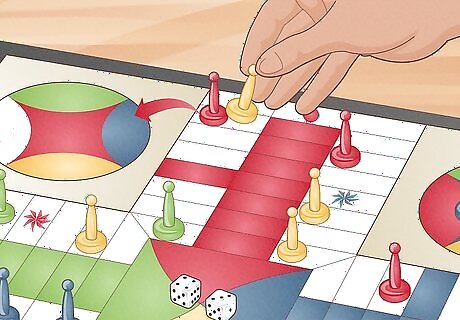
Land on an opponent’s pawn to send them back to Start. If one of your pawns lands on a spot occupied by your opponent, they have to put their pawn back in their Start circle. When you capture an opponent’s pawn, you get to move one of your pawns forward an extra 20 spaces. However, if you don’t have a single pawn that can move forward the full 20 spaces, you’ll have to forfeit your bonus. The bonus can’t be split between multiple pawns. You’re only allowed to move 1 pawn forward 20 spaces. If you capture your opponent’s pawn using just one die, continue your move with the same pawn or move a different pawn with the remaining die. Then, take your bonus before ending your turn.
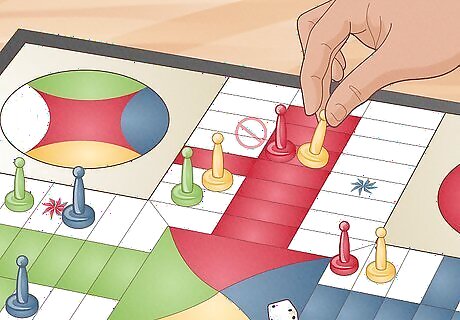
Don't capture pawns that are on their Home path or Safety spaces. A player’s Home path is the stretch of red spaces (or the same color as their pawns in some versions) to the left of their Start circle. Your pawns can’t enter another player’s Home path. Safety spaces are usually blue spaces with a circle inside. When a player’s pawn is on this space, you can’t capture them. Two pawns that are different colors can’t occupy the same Safety space, meaning you can’t move your pawn forward if it means they’ll end up on a Safety space with your opponent’s pawn. The only exception is when a player’s pawn is on your Enter space (which is also a Safety space) when you bring out a pawn. In that case, you send their pawn back to Start and get the 20-space bonus when you bring out a pawn. You can create blockades on Safety spaces.
Reaching Home & Winning
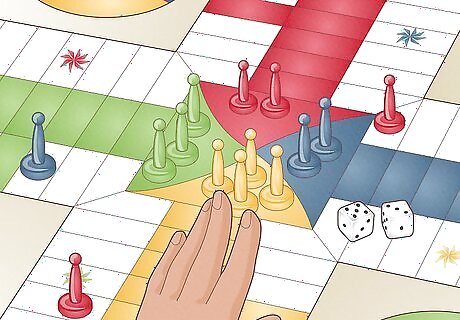
Get all 4 pawns into Home to win. Once you’ve completed one full rotation around the board, move your pawns up the Home path to the left of your Start circle to bring them into Home. In order to bring a pawn into Home, you must roll the exact number needed. The Home space also counts as one spot, so if there are 7 spots on your Home path, you would need a total of 8 to move a pawn along the Home path and into Home. Your pawns can only enter your own Home path and not your opponents’.
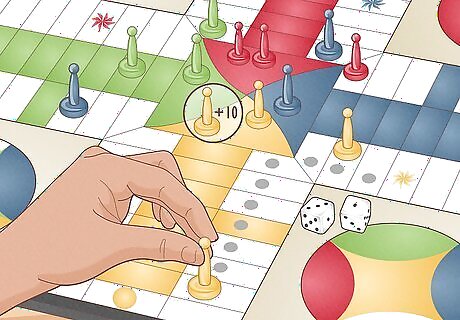
Move 1 pawn forward 10 spaces each time you get a pawn into Home. You get a 10-space bonus every time you move one of your pawns into Home. This bonus can only be used to move 1 pawn forward and can’t be split between multiple pawns. If you don’t have any pawns that can move forward the full 10 spaces, you forfeit the bonus.




















Comments
0 comment